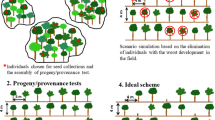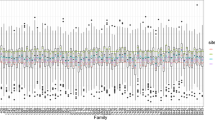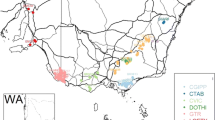Abstract
Tree planters of the Yucatan peninsula in México are mostly first-generation small-scale forest owners. As a consequence of the lack of a management plan, trees employed for plantations are currently produced without any traceability or genetic improvement protocol, resulting in the reduced quality and heterogeneity of established materials. Recently, the Mexican government published a law to force planters to reverse this situation through the initiation and operation of germplasm management and traceability programs within each physiographic sub-province. Thus, planters located in the “Campeche Karts sub-provenance” now need to select superior trees for plant production, provenance assays, and orchard establishment. As a reference for the improvement goals in this work, we developed a model ideotype tree and qualification tool based on a weight-free selection index to compare trees in established plantations to enable the effective selection of superior trees to be used as seed sources and as a starting population for genetic improvement programs. The tool presented here is easy to use by planters, requiring a very basic computer or smartphone to run a spreadsheet where simple morphometric evaluation are captured, trees are qualified in comparison to the ideotypic values of each parameter with the aid of common field equipment. When this tool was applied to individuals from two different plantations, the qualification methodology ranked the individuals, allowing for the selection of superior trees in a more robust way, in contrast to the use of parameters mostly based on price and driven by wood volume.



Similar content being viewed by others
References
AHEC (2015) The illustrated guide to American hardwood lumber grades. http://americanhardwood.org/es/productos-y-procesos/clasificacion-introduccion/. Accessed 30 Jan 2015
Aitken SN, Yeaman S, Holliday JA et al (2008) Adaptation, migration or extirpation: climate change outcomes for tree populations. Evol Appl 1:95–111. doi:10.1111/j.1752-4571.2007.00013.x
Borchert R, Tomlinson PPB (1984) Architecture and crown geometry in Tabebuia rosea (Bignoniaceae). Am J Bot 71:958–969. doi:10.2307/2443666
Cavers S, Navarro C, Lowe AJ (2004) Targeting genetic resource conservation in widespread species: a case study of Cedrela odorata L. For Ecol Manag 197:285–294. doi:10.1016/j.foreco.2004.05.019
Cornelius JP, Watt AD (2003) Genetic variation in a Hypsipyla-attacked clonal trial of Cedrela odorata under two pruning regimes. For Ecol Manag 183:341–349. doi:10.1016/S0378-1127(03)00142-7
Cornelius JP, Mesén JF, Corea EA (eds) (1994) Mejoramiento genetico forestal, 1st edn. Bib. Orton IICA/CATIE, Turrialba
Dickmann DI (1985) The ideotype concept applied to forest trees. In: Cannell MGR, Jackson JE (eds) Attributes of trees as crop plants, 1st edn. Titus Wilson & Son Ltd, London, pp 89–101. ISBN 0-904282-83-X
Dickmann DI, Gold MA, Flore JA (1994) The ideotype concept and the genetic improvement of tree crops. In: Janick J (ed) Plant breeding reviews, vol 12. Willey, New York, pp 163–193. ISBN 0-470650-48-6
Elston RC (1963) A weight-free index for the purpose of ranking or selection with respect to several traits at a time. Biometrics 19:85–97
Galán Larrea R, Santos Posadas HM, Valdez Hernández JI (2008) Crecimiento y rendimiento de Cedrela odorata L. y Tabebuia donnell-smithii Rose en San José Chacalapa, Pochutla, Oaxaca. Madera y Bosques 14:65–82
García Cuevas X, Flores Garnica G, de Benavides Solorio J de D (2007) Índice de sitio para Cedrela odorata (cedro rojo) en Quintana Roo, México. Cienc For en México 32:71–92
González-Rodríguez JA, Ramírez-Garduza F, Robert ML et al (2010) Adventitious shoot induction from adult tissues of the tropical timber tree yellow Ipé primavera (Tabebuia donnell-smithii Rose [Bignoniaceae]). In Vitro Cell Dev Biol Plant 46:411–421. doi:10.1007/s11627-010-9304-9
Hallé F, Oldeman RAA, Tomlinson PB (1978) Tropical trees and forests. An architectural analysis. Springer, New York. ISBN 3540084940
INEGI (2015) Fisiografía de México. http://www.inegi.org.mx/geo/contenidos/recnat/fisiografia/. Accessed 30 Jan 2015
Leakey RRB, Page T (2006) The “Ideotype Concept” and its Applications to the Selection of Cultivars of Trees Providing Agroforestry Tree Products. For Trees Livelihoods 16:5–16
Moreira PA, Fernandes GW, Collevatti RG (2009) Fragmentation and spatial genetic structure in Tabebuia ochracea (Bignoniaceae) a seasonally dry Neotropical tree. For Ecol Manag 258:2690–2695. doi:10.1016/j.foreco.2009.09.037
Navarro C, Ward S, Hernández M (2002) The tree Cedrela odorata (Meliaceae): a morphologically subdivided species in Costa Rica. Rev Biol Trop 50:21–29
Perez Gonzalez G, Dominguez-Dominguez M, Martínez-Zurimendi P, Etchevers Barra JD (2012) Caracterización dasométrica e índice de sitio en plantaciones de caoba en Tabasco, México. Madera y Bosques 18:7–24
Secretaría de Economía (2016) Declaratoria de vigencia de la Norma Mexicana NMX-AA-169-SCFI-2016. Diario Oficial de la Federación. Oct 3. México. http://www.dof.gob.mx/nota_detalle.php?codigo=5455455&fecha=03/10/2016. Accessed at 2 Feb 2017
SEMARNAT (2010a) Norma Oficial Mexicana NOM-059-SEMARNAT-2010, Protección ambiental-Especies nativas de México de flora y fauna silvestres-Categorías de riesgo y especificaciones para su inclusión, exclusión o cambio-Lista de especies en riesgo. Diario Oficial de la Federación. Dec. 12. México. http://dof.gob.mx/nota_detalle.php?codigo=5173091&fecha=30/12/2010. Accessed at 2 Feb 2017
SEMARNAT (2010b) Manual para la identificación y establecimieto de Unidades Productoras de Germoplasma Forestal, 1st edn. Guadalajara. México. http://www.conafor.gob.mx:8080/documentos/docs/19/1290Manual%20para%20la%20identificaci%C3%B3n%20y%20establecimiento%20de%20Unidades%20productoras%20de%20Germoplasma%20Forestal.pdf. Accessed at 2 Feb 2017
Suárez IE, Jarma AJ, Avila M (2006) Desarrollo de un protocolo para propagación in vitro de roble (Tabebuia rosea Bertol DC). Temas Agrar 11:52–62
Timofte AI, Budău R, Timofte CS (2012) Influence of processing logs’ conicity upon the output when log conversion. Analele Univ din Oradea, Fasc Prot Mediu 19:587–594
Vallejos J, Badilla Y, Picado F, Murillo O (2009) Metodología para la selección e incorporación de árboles plus en programas de mejoramiento genético forestal. Agronom Cost 34:105–119
Acknowledgements
The authors are indebted to El Colegio de la Frontera Sur for the financial support received through the research Grant 5103711808 2013-2016. We thank Mr. Aroldo Ku (owner) and Mr. Leonel Villatoro (technician from Argos Marañón SA de CV) for granting permission to work on their plantations. ISG thanks El Colegio de la Frontera Sur for the scholarship received. JJG is grateful to Consejo Nacional de Ciencia y Tecnología for the scholarships granted.
Author information
Authors and Affiliations
Corresponding author
Electronic supplementary material
Below is the link to the electronic supplementary material.
Rights and permissions
About this article
Cite this article
Solís-Guillén, I., Chaires-Pacheco, M., Juárez-Gómez, J. et al. Development of an Ideotype-Based Selection Tool for Native Tropical Tree Breeding by Smallholder Planters in Mexico’s Maya Forest. Small-scale Forestry 16, 521–534 (2017). https://doi.org/10.1007/s11842-017-9368-z
Accepted:
Published:
Issue Date:
DOI: https://doi.org/10.1007/s11842-017-9368-z




